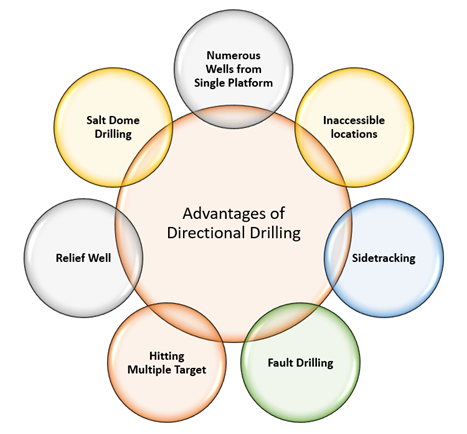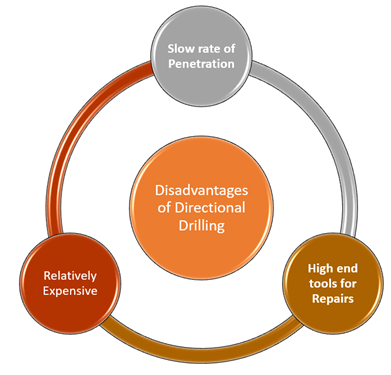What is Directional Drilling?
Directional drilling is the technique used in the oil industry to extract hydrocarbons from the subsurface. The method includes drilling and controlling a deviated well to hit a predetermined target. Usually, wells are positioned vertically above the reservoir for hydrocarbon extraction and drilled straight to hit the reservoir for the extraction of hydrocarbons. However, directional drilling involves drilling an inclined well to hit the target.
The technique has a number of benefits, but the most important benefit of directional drilling is that it allows the extraction of hydrocarbons from inaccessible reservoirs.
How Directional Drilling Works?
In a vertically straight well, the rotary torque to the drill bit is provided from the rotary table present on the surface, which rotates the whole drill string. But it becomes impossible to provide rotary torque to a drill bit in an inclined well because the complete drill string can't rotate in this case. The process utilizes a bend near the drill bit, which provides direction to the wellbore, and a downhole steerable mud motor is used to rotate the drill bit. The mud motors are run by the force of drilling fluid which is pumped through it. The pressure exerted by the mud pushes the drill bit to drill the formations.
Rotary Steerable Systems are also used to direct the drill bits in the right direction while operating from the surface. In addition to that, Measurement while Drilling tools are also incorporated to get the bit inclination details.
What is the history of Directional Drilling?
The directional drilling technique has been used in the oil and gas industry since the 1920s. Previously, the directional drilling was done with basic equipment, and the wells are drilled at a non-vertical angle. However, modern directional drilling techniques have revolutionized this process by refining the process. The use of modern tools like hydraulic jets, specialized drill bits, mud motors, Rotary Steerable Systems has improved the reliability of the technique.
Nowadays, companies are using advanced computing software which fetches the data from sensors mounted on the Bottom Hole Assembly to adjust the direction and angle of the drill bit on a real-time basis. Engineers are able to create three-dimensional models of the reservoirs to determine the best location and path for drilling a well.
What are the types of Directional Well Profiles?
There are three different shapes of a directional well that are described below:
- Build-and-hold Well: In this type of well drilling is advanced in a straight pattern after achieving initial deflection is at a shallow depth.
- S-Shaped Well: S-shaped well also takes an initial deflection at a shallow depth, and afterwards, drilling is done until an appropriate lateral displacement is achieved. The borehole is again returned to the vertical pattern until the target depth is reached.
- Continuous-build Well: In this type of well, a continuous build starts its deviation with a relatively high angle. The lateral distance from the desired penetration point to the vertical is short in these wells.
Summary:
- Directional drilling is a process of drilling an inclined well to hit the underground reservoir to extract hydrocarbons.
- Directional drilling has numerous advantages, like it increases the recovery of hydrocarbons and helps extract hydrocarbons from inaccessible reservoirs.
- The recent technological advancement in the process of introducing mud motors and rotary steerable systems has refined the directional drilling process.
FAQs:
What are the advantages of Directional Drilling?
There are numerous advantages of drilling a directional well. Let us glance in brief at these advantages:

Copyright © 2021 Kalkine Media Pty Ltd
- Numerous Wells from Single Platform: Directional Drilling allows the operator to drill multiple wells from a single drilling platform which helps to reduce the drilling cost and environmental impacts too. This technique has shown tremendous results in field development during offshore drilling.
- Inaccessible locations: The other major advantage of directional drilling is seen where surface located above the underground reservoirs is inaccessible. A directional well to hit the reservoir is drilled from a different surface location. A rig is remotely placed, and a directional well is drilled in this case.
- Sidetracking: Sidetracking is another very important application of directional drilling. The technique allows drilling around an obstruction that may come into the picture due to a complex geological feature or due to a drilling obstruction like lost string. A blind sidetrack is done to overcome this type of problem.
- Fault Drilling: It becomes very difficult for a drilling company to drill across an inclined geological fault. Formation pressure and the possibility of slippage makes it difficult to drill vertically along a fault. So, a perpendicular or parallel deflected wellbore is drilled across a fault for better production.
- Hitting Multiple Target: The process is a very economical way to intersect multiple production targets with a single well. It also increases the production rate enormously.
- Relief Well: Relief wells are drilled to control a wild well. Water and high-density mud are pumped into the relief well to kill high pressured well. Since the wild well is intersected near its source so, directional control is mandatory for this application.
- Salt Dome Drilling: When a reservoir is located under the hanging cap of a salt dome, drilling a vertical well through the salt dome becomes very difficult as it may lead to lost circulation, washouts and corrosion. To avoid these challenges, inclined wells are drilled to hit the reservoir.
What are the Disadvantages of Directional Drilling?
Although directional drilling has various advantages, every coin has two faces. So, let us try to understand few disadvantages of directional drilling.

Copyright © 2021 Kalkine Media Pty Ltd
- Expensive: The directional drilling process is relatively far more expensive than a conventional vertical well drilling process as it requires high-end equipment.
- A slow rate of Penetration: The process has a relatively slow rate of penetration as it requires extra attention for checking the inclination and direction of a drill bit.
- High-end tools for Repairs: The technique requires the mobilization of high-end tools in case of requirement of any repairs on an underground tool.
 Please wait processing your request...
Please wait processing your request...